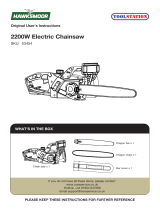POWXG1007 EN
Copyright © 2019 VARO P a g e | 6 www.varo.com
▪ If the chain gets stuck when sawing with the upper side it may be thrust towards the
operator. For this reason you should saw wherever possible with the bottom side, as the
chainsaw will then be thrust away from the body towards the wood (see Fig, 9 and 10).
▪ Pay extra attention when cutting splintered wood. Sawed off pieces of wood may be
catapulted in any direction (risk of injury!)
▪ Do not use the chainsaw to remove nails or similar objects.
▪ When lopping off branches, the chain saw should be supported wherever possible against
the trunk, Do not cut with the tip of the guide bar (risk of kick-back, see Fig. 8).
▪ Leave branch lopping work should be carried out by trained personnel! Risk of injury!
▪ Pay special attention to branches under tension. Do not cut through freely suspended
branches from underneath.
▪ Never stand on the trunk when loping off branches.
▪ The chainsaw should not be used for forest work, i.e. for felling and lopping off branches in
the forest. Because of the cable connection the saw operator does not have the necessary
mobility and his safety is not guaranteed!
▪ Always stand to the side of the tree being felled.
▪ When the tree is being felled, watch out for falling branches when stepping back.
▪ On slopes the saw operator should stand to the upper or left or right side the trunk or lying
tree, never to the bottom side.
▪ Watch out for trunks rolling towards you. Kick-back!
▪ The power saw is likely to recoil if the tip of the guide bar (especially the top quarter)
accidentally touches wood or any other solid objects. In this case the saw will move
uncontrolled and will be hurled towards the operator at full power (risk of injury!).
▪ When working with the chain saw, protective gloves, suitable shoes, leg protectors, eye
protectors and ear protectors should be used.
▪ If the work involves any risk of head injury, a safety helmet must be worn When cutting
down trees and cutting and cutting off branches of felled or fallen trees. in addition a face
protector should be worn.
▪ Always pull the plug from the socket outlet before attempting to check or adjust the chain
or to correct some fault and whenever moving one workplace to another.
▪ Never switch on the chain saw unless you have a firm hold of the tool. a secure footing
and are sure that the guide bar and saw chain are not touching anything.
▪ Always hold the saw with both hands (right hand on rear handle, left hand on handle (2).
▪ Never saw above shoulder height, while standing on a ladder or in a tree or in any other
insecure position.
▪ When sawing timber that has split, take particular care that no small pieces of wood are
broken off and thrown by the saw chain.
▪ During breaks, the saw should be laid down in such a way that there is no risk of injury to
anyone from the saw chain.
▪ The chain saw should never be lent to or be allowed to come into the hands of persons
who are not familiar with the use of such a tool. The operating Instructions should also go
with the saw.
6 KICKBACK
In order to prevent kick-back, please follow these safety instructions:
▪ Never start cutting with the tip of the guide bar!
▪ Never cut with the tip of the guide bar! Be careful, when continuing cuts you are already
working on!
▪ Always start cuts with the chainsaw already running!
▪ Make sure that the saw chain is always properly sharpened.
▪ Never cut through more than one branch at a time! When lopping off branches, be careful
not to touch any other branches.


















